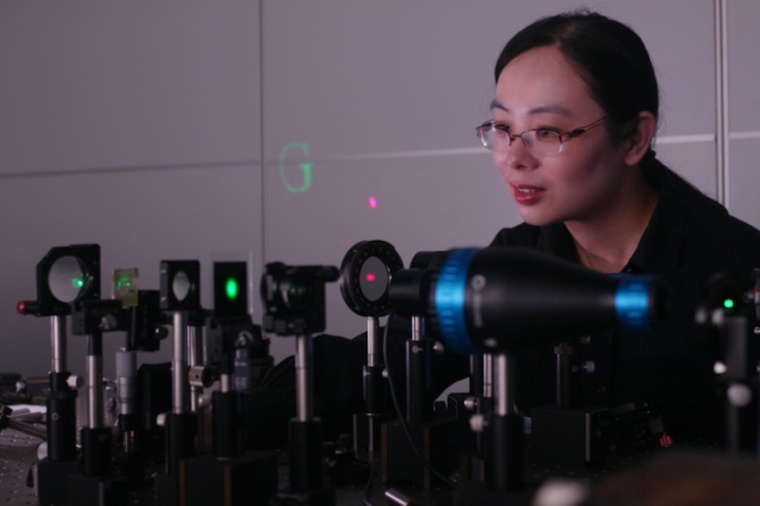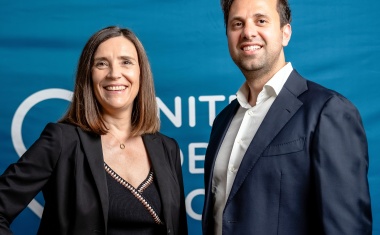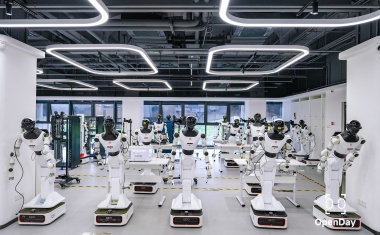Tunable lenses for virtual reality headsets
Variable focus length lays groundwork for more comfortable, realistic AR/VR experiences.
Researchers have developed a thin lens with a continuously tunable focal length. The new lens could one day make visual fatigue from augmented and virtual reality (AR/VR) devices a thing of the past. “Many of the 3D displays used in today’s AR/VR devices cause discomfort after long-term use due to the vergence-accommodation conflict,” said research team leader Yan Li from Shanghai Jiao Tong University in China. “Our lens, which is known as an Alvarez lens, can be used to alleviate this problem. This could provide a more comfortable and more realistic 3D experience that would enable more widespread use of AR/VR headsets.”

The new lens is made from two flat, or planar, liquid crystal elements that can be moved in relation to each other to continuously change the lens’s focal length. To demonstrate the new Alvarez lens, they incorporated it into an AR display system that displayed virtual images on a real-world view at different depths. “This lens has a continuous and large tuning range, a thin formfactor, is lightweight and can be made using a simple low-cost fabrication process,” said Li, who collaborated with Shin-Tson Wu’s lab at the University of Central Florida College of Optics and Photonics. “In addition to AR/VR devices, this type of compact tunable lens could be useful for microscopic imaging, machine vision, laser processing and ophthalmology.”
In AR/VR devices, the vergence-accommodation conflict occurs because the left and right eyes receive two slightly different images that the brain puts together to form a virtual 3D image. To see the image clearly, each eye focuses on the fixed 2D plane where the image is displayed. This causes the merged 3D image and the single eye focus at the 2D plane to be inconsistent, leading to dizziness and visual fatigue.
It’s possible to lessen the vergence-accommodation conflict with a vari-focal display, which dynamically changes the depth of single-plane virtual objects so that virtual objects appear to exist at different depths in different moments. Another option is a multi-focal display system, which renders multiple 2D cross-sections of a virtual object at multiple depths simultaneously to reconstruct a 3D volume. In both cases, the VAC problem is suppressed because the human eye can focus on the correct depths of the virtual objects.
Vari- or multi-focal display systems need a tunable lens that can change focus continuously within a large range while also being compact and lightweight enough to be useful in head-mounted AR/VR devices. Li has been working on fatigue-free AR displays and liquid crystal devices for about 10 years and recently developed a way to fabricate a liquid crystal based diffractive optical component known as a Pancharatnam-Berry (PB) optical element that can be used to create a tunable lens that meets these requirements.
“Our method enables Pancharatnam-Berry optical elements with the complicated and irregular phase profiles needed to create an Alvarez lens with high precision, low cost and unprecedented convenience,” said Li. “We wanted to see if this ultracompact Alvarez tunable lens could offer a solution to the long-standing vergence-accommodation conflict problem in VR and AR displays.”
The researchers used their new approach to create a tunable Alvarez lens made of two planar Pancharatnam-Berry liquid crystal elements. In each element, an ultrathin polymetric liquid crystal layer just a few hundred nanometers thick is coated onto a 1-mm-thick glass substrate. They incorporated this Alvarez lens into an AR display system built using off-the-shelf optical elements on an optical table. By laterally shifting the two elements of the Alvarez lens, they were able to continuously tune the depth of the virtual image from near to far distances.
“No matter the depth, the virtual image exhibited the same in-and-out of focus effect as the real 3D objects in the real world,” said Li. “This meant that the human eye could always focus on the depth of the virtual 3D image correctly, thus overcoming the vergence-accommodation conflict problem.” The Alvarez lens demonstrated in this work was optimized for single-color operation at 532 nanometers, but the researchers are working on ways to use it for a full-color display. They also want to adopt an electronic method for controlling the lateral displacement between the optical elements, which was performed manually in this research. (Source: Optica)
Link: Dept. of Electronic Engineering, Shanghai Jiao Tong University, Shanghai, China











